| African & Madagascar species1 | |
|---|---|
|
D. acaulis5 D. admirabilis4,5 D. affinis7 D. alba5 D. aliciae5 D. bequaertii7 D. burkeana6,8 D. capensis5 D. cistiflora5 D. coccipetala5 D. collinsiae5 D. cuneifolia5 D. curvipes5 D. dielsiana6 D. elongata7 D. ericgreenii5 D. esterhuyseniae5 D. flexicaulis7 |
D. glabripes5 D. hilaris5 D. humbertii8 D. indica2,8,9 D. katangensis7 D. madagascariensis7,8 D. natalensis6,8 D. nidiformis5 D. pauciflora5 D. pilosa7 D. ramentacea5 D. regia3,5 D. rubrifolia5 D. slackii5 D. trinervia5 D. venusta5 D. xerophila5 D. zeyheri5 |
|
1All in Drosera sect. Ptycnostigma unless otherwise noted. 2In Drosera sect. Arachnopus. 3In Drosera sect. Regiae. 4Closely related to D. cuneifolia. 5Endemic to South Africa. 6Native but not restricted to South Africa. 7Tropical Africa. 8Found on Madagascar. 9In Asia and Africa. |
|
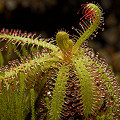
Drosera cistiflora
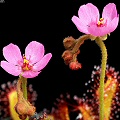
Drosera collinsiae
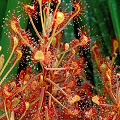
D. madagascariensis
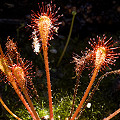
Drosera nidiformis
Q: African and Madagascan Drosera species
A: Africa is an enormous continent, and contains about 65 carnivorous plant species. Many of
these are sundews. Most are occur in southern Africa, but there are a few species that are
endemic to tropical Africa. The large island of Madagascar, as troubled as it is by extreme deforestation pressures, adds
D. humbertii to the inventory of sundews.
South African species
South Africa is well known as a land of spectacular botanical diversity. This is partly
because it is one of the few places on the Earth blessed with what is called a Mediterranean climate, that is a hot dry
summer and a mildly cool, wet winter. Fire is also a vigorous factor that clears vegetation by frequent burns. These
factors contribute to a great botanical biodiversity in the South African landscape (actually, there are many other
reasons for the biodiversity, including soils etc., but I would be getting off-track if I started in that direction.)
Most of the Drosera of South Africa fall into three main groups. The first group consists of the
flat rosetted species such as D. aliciae. These have leaves that are spathulate (spoon shaped)
or perhaps wedge-shaped. It is often very difficult to distinguish one species from the next.
A second group consists of stem-forming plants such as D. capensis
or D. madagascariensis. The third main group includes the
tuber-rooted species such as D. cistiflora.
As you might expect, there is some controversy regarding these species for example, should some be merged or split. It is
sometimes something of a mess.
Northwards, the continent has several more Drosera species that live in
tropical areas. It appears that much of
the African continent has been underbotanized with regards to its carnivorous flora, and it would surprise no one if a
comprehensive study revealed more species. Political unrest and instability no doubt
contributes to this lack of knowledge about Africa.
Drosera affinis
This species looks much like D. madagascariensis. It produces
a basal rosette, which then forms an elongated stem up to 25 cm long.
The plant "D. flexicaulis" is probably a synonym.
Drosera bequaertii
A plant that has a short stem only 3 cm long, and small leaves with petioles
5-8 mm long and leaf blades 4 mm wide and 8 mm long. In the original description, Taton described the plant as having yellow
flowers, but this is probably a mistake derived from looking at faded herbarium specimens. The species
"D. compacta " is probably the same as D. bequaertii.
Drosera curvipes
If you are looking for the now defunct Drosera longiscapa, it went here!
Reports of Drosera madagascariensis in South Africa actually are due to misidentifications of this species, as well as of
Drosera nidiformis.
Drosera elongata
This scrambling species has an enormously long stem, up to 90 cm long. Leaves
are scattered evenly along this stem. Despite the long stem, the leaves are small--the leaf blades are only 3 mm wide and
6 mm long, on petioles 1-1.5 cm long.
Drosera indica
Sprawling both in habit, and in range, and occurs in much of Africa and Madagascar. The lead
species in the "Drosera indica complex."
Drosera madagascariensis
A stemmed, scrambling species that is quite easy to grow. A common species widespread throughout tropical mainland Africa, just absent
from southern Africa--i.e., below about 35° S (A. Fleischmann, pers. comm. 2018). Also, of course, found in Madagascar.
Drosera katangensis
A long-stemmed species up to 15 cm tall, with petioles 7-20 mm long, and leaf
blades 1.5-5 mm wide and 5-15 mm long. The flowers are white with pink veins.
Drosera pilosa
Unlike the other stem-forming species of tropical Africa, this is a small, rosetted
species with a very hairy surface.
Drosera regia
A South African endemic, and has enormous, sword-shaped leaves. It contends
for being the largest sundew, depending upon what you are measuring.
Drosera trinervia
Drosera trinervia--a South African species that has absorbed Drosera afra.
Drosera ×corinthiaca
This is a naturally occurring hybrid of
Drosera aliciae×glabripes.
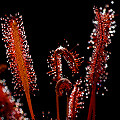
Red Drosera capensis
Cultivation
Many of the showiest South Africa Drosera are also the easiest to grow.
These easy species respond to standard carnivorous plant cultivation---peat:sand mix, bright light, warm temperatures, plenty of moisture.
Some are so sturdy, they actually have a fighting chance on the "bright windowsill" that has caused the death of so many other
carnivorous plants. D. affinis is easy to grow as a tropical
Drosera.
Interestingly, plants such as
Drosera aliciae, D. capensis, and D. madagascariensis may make a seasoned
grower roll his or her eyes in exaggerated
boredom, but let's face it---Drosera capensis really is a marvelous species.
Just because they are easy to grow and do well in cultivation is no excuse for not appreciating
them---it is all the reason to appreciate them even more!
Page citations: D'Amato, P. 1998a; Degreef, J.D. 1990; Fleischmann, A. 2018;
Fleischmann, A. et al. 2008; Lowrie, A. et al. 2017a, 2017b; Rice, B.A. 2006a; Robinson, A. et al. 2017;
Schlauer, J. 1996, 2002;
Taton, A. 1945.